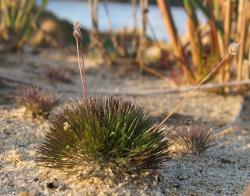Perennial or annual, leafy, moss-like cushions or small solitary tufts. Stems branching or condensed without discernible internodes; producing axillary adventitious roots. Leaves grass-like with open sheaths. Flowering stem a scape. Inflorescence a terminal spike with opposing or alternating sheathing bracts subtending female and/or bisexual reproductive units, or a solitary bisexual flower. Androecium 1 or 2 stamens; anthers dorsifixed, versatile, bisporangiate unilocular, dehiscing by a slit; pollen grains 1-porate. Gynoecium a multilocular ovary of superposed carpels in 1 or 2 rows, or a single carpel, or a collateral bilocular ovary; ovules solitary; styles as many as carpels; stigmatic region papillate. Flowers wind pollinated or selfed. Fruit a capsule. Seeds dehiscent.
Analyses using chloroplast DNA data are conflicted as to whether the centrolepids should remain as a separate family or be placed in the Restionaceae (Briggs B.G.; Linder H.P. 2009; Briggs et al. 2010). Traditionally the family has been separated from the Restionaceae on the basis of leafiness, monoecism (vs dioecism), the sometimes presence of an annual habit, and the unusual reduced floral structures that have either been interpreted as pseudanthia (Eichler 1875; Moore & Edgar 1970; Cooke 1988) or as bisexual flowers (Hieronymus 1873; Cheeseman 1925; Sokoloff et al. 2009).
| 1 | Inflorescence a spike with 2–3 alternate bracts; reproductive unit (a true flower) with 2 collateral carpels, stamens 2 | Gaimardia |
| Inflorescence a spike with 2 opposing bracts; Reproductive units with 1 carpel or 2-many superposed carpels, stamens 1 or absent | Centrolepis |
| Category | Number |
|---|---|
| Indigenous (Endemic) | 2 |
| Indigenous (Non-endemic) | 3 |
| Exotic: Casual | 1 |
| Total | 6 |




